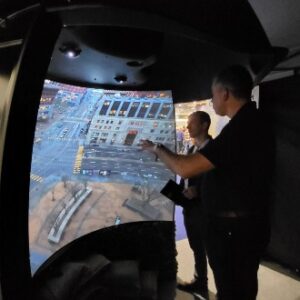My first visit to Integrated Systems Europe felt, at times, like I was a participant in a Blade Runner sequel. 80,000 expresso-fuelled technology addicts competing for air, space, and attention across a 15-building MegaMart of pixels, decibels, gigahertzes and lumens for the home, office and Third Places.
Helping extend the dystopian feel were more square meters of direct-view LED screens than I’ve ever seen, including a recent visit to Times Square. Indoor, outdoor, fixed, portable, micro, high bright, flexible, transparent and spectacularly TV-like products were all on display, many in full 4K (or more) glory.
Here’s what I’ve concluded:
LED is no longer the future of large commercial displays. LED is the here, the now and the best choice for many (or most?) large display applications. Unlike tiled video walls, there are no bezel compromises. Unlike projection screens, there are no contrast or brightness compromises. And, with advances in technology, there are no longer any colour rendering or black level compromises either.
I saw amazing LED displays at ISE. Deepsky’s micro-LED had blacks rivaling LG’s OLED TVs. Samsung’s commercially-available 1.5mm panels showed HDR-quality colour. There were great LED displays from companies AV people might know: Barco, Christie Digital, Mitsubishi and Planar/Leyard. There were also great LED displays from companies those of us who’ve been in the LED business for a few years might know: Absen, Lighthouse, Silicon Core and Unilumen. And great LED displays from companies you may have never heard of – but should get to know: AOTO, Chainzone, Coleder, InfiLED, ROE and others.
The biggest problem with LED display technology today is not which screen is better. The biggest problem is deciding who to buy from. For both AV integrator/resellers and our customers, these will be difficult, confusing and stressful times as we figure out how to navigate the technology, the marketplace, and the products.
I’m old enough to remember Honda and Toyota, then KIA and Hyundai’s first cars in North America. Each sold very cheap cars at very low prices and, while my used ’73 Civic fit my student budget and delivered 50 mpg (4.7L/100km), all I remember is that it did not always get me where I needed to go.
Caveat Emptor! Today’s low-price, no-name Shenzhen LED mills may well be the Toyotas and Hondas of tomorrow. But, for at least today, I’m not buying. LED display procurement cannot and should not be devolved into a comparative discussion about pixel pitch, NITS, price per square meter or even chip-on-board tech. And the discussion cannot even about quality – because, frankly, we have no way of knowing what ‘quality’ will find its way into that overseas shipping container.
My conclusion? We – and our clients – will be buying LED displays from well-established Brands, the people behind those Brands, and the readily available service and support they’re able to deliver today. We’ll be buying from nearby vendors able to provide our clients with a full-scale demonstration; not just a website or brochure or road case pop-up. And, while we’ll lose a few deals, we and our smart customers will sleep better for it.
And no, I’ve never bought another Honda. And never will.
Brock McGinnis is Vice-President, Sales of Westbury National Audio + Visual Solutions division. He’s enjoyed a long career delivering practical and sustainable technology solutions for his clients’ presentation, communication, collaboration and entertainment needs.
Photo credit: Lucan Coutts.
POPULAR
New-build Beijing Performing Arts Centre Features Four L-Acoustics Installations in Stereo...
The Beijing Performing Arts Centre (BPAC), an extension of the National Centre for the Performing Arts, features L-ISA immersive sound technology in three performance spaces, including the Opera House, Multi-Function Theatre, and Outdoor Theatre, enhancing the cultural narrative of the Grand Canal.









